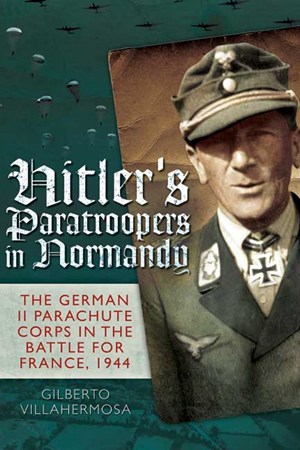HITLER'S PARATROOPERS IN NORMANDY
In June 1944, Allied forces fighting desperately to establish a foothold in Normandy and then breakout of the confining bocage found themselves opposed by a bewildering array of formations of the German Wehrmacht. Among them were the newly formed German II Parachute Corps. This gripping new account examines the exploits of Germanys II Parachute Corps and its commander, Eugen Meindl from the Allied invasion on 6 June to the end of August 1944. Meindl was the epitome of the senior German airborne commander in the Second World War. Tough, experienced, and aggressive, he cared deeply for his troops. His Parachute Corps fought stubbornly for three weeks, before being forced to fall back. Trapped along with the bulk of the German Seventh Army in the Falaise pocket, Meindl and his paratroopers maintained their discipline and were selected by the Commander in Chief of OB West to lead the German breakout to the east. That they managed to do so, despite suffering grievous losses, while so many around them died or surrendered, is a testament to their dedication and fighting ability.
REVIEW
This fascinating insight into Hitler's Fallschirmjägers shows that although these elite soldiers were a shadow of their former selves by 1944, they were still an dangerous opponent and defended Normandy fiercely. Fighting as infantry, the part played by II Parachute Corps in the Normandy '44 campaign was one of courage and also lost hope. Although fighting with savage bravery and determination in the face of superior allied infantry, armour, and air cover, it was obvious to many German’s that the tide of war had not only changed, but the end was in sight now the Allies had landed in France. By the end of 1944 their huge losses was testament to this end.
The book charts the Fallschirmjägers defences from St- Côme-du-Mont, Caretan, Hill 192, Hill 122, Mont-Castre, St- Lô, Sainteny and Brest. Fighting ranged from the open, to urban to the infamous bocage, the hedgerow terrain of this part of France with its narrow lanes and woods, ideal for defence. Outnumbered from the beginning with few replacements and no air cover the remnants of the 2nd, 3rd, 5th and 6th Parachute Regiments are charted until the final encirclement and collapse of the Falaise pocket and retreat towards Germany.
The author, Gilberto Villahermosa, is a retired US Army Colonel so we have an advantage of a military man, a paratrooper himself giving a well-researched and thorough study of these shattered Fallschirmjäger in France, their leadership, tactics and weapons. A good selection of photos and maps are included although the latter could have been larger and a little clearer. B&W maps are always going to be a challenge in a book of this format when we are talking some large areas of Normandy, but nevertheless are fine.
A very good, detailed, well written and balanced book on the Fallschirmjäger in Normandy.


